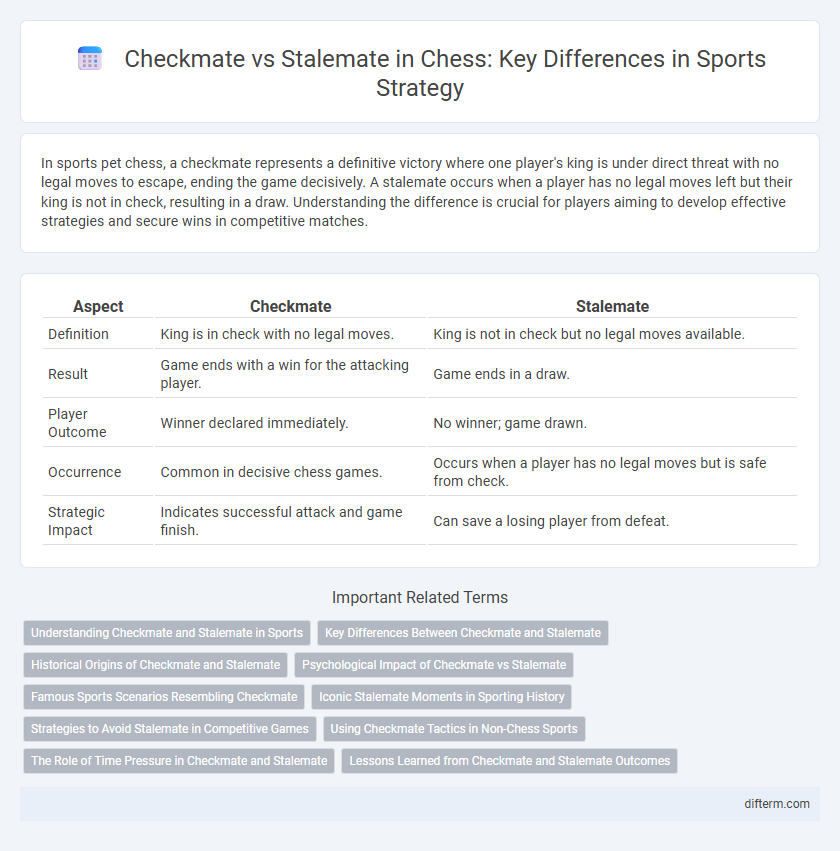In sports pet chess, a checkmate represents a definitive victory where one player's king is under direct threat with no legal moves to escape, ending the game decisively. A stalemate occurs when a player has no legal moves left but their king is not in check, resulting in a draw. Understanding the difference is crucial for players aiming to develop effective strategies and secure wins in competitive matches.
Table of Comparison
| Aspect | Checkmate | Stalemate |
|---|---|---|
| Definition | King is in check with no legal moves. | King is not in check but no legal moves available. |
| Result | Game ends with a win for the attacking player. | Game ends in a draw. |
| Player Outcome | Winner declared immediately. | No winner; game drawn. |
| Occurrence | Common in decisive chess games. | Occurs when a player has no legal moves but is safe from check. |
| Strategic Impact | Indicates successful attack and game finish. | Can save a losing player from defeat. |
Understanding Checkmate and Stalemate in Sports
Understanding checkmate and stalemate in sports, particularly in chess, revolves around the endgame scenarios where players must anticipate strategic moves to secure victory or avoid defeat. Checkmate occurs when a king is under direct threat of capture with no possible escape, resulting in an immediate loss for the player in check. Stalemate arises when a player has no legal moves left but is not in check, leading to a draw and emphasizing the importance of tactical foresight in competitive play.
Key Differences Between Checkmate and Stalemate
Checkmate occurs when a player's king is in direct threat of capture and cannot make any legal moves to escape, resulting in an immediate loss. Stalemate happens when a player has no legal moves left but their king is not in check, leading to a draw. The key difference lies in the presence of check: checkmate ends the game with a winner, while stalemate ends in a tie.
Historical Origins of Checkmate and Stalemate
The historical origins of checkmate trace back to ancient India, where the game of chaturanga, a precursor to modern chess, introduced the concept to signify the capture of the king. Stalemate emerged later as a defensive mechanism in medieval European chess, reflecting evolving strategic complexity and rules adaptations. Both terms illustrate the game's rich evolution, influencing competitive play and chess theory worldwide.
Psychological Impact of Checkmate vs Stalemate
Checkmate delivers a definitive psychological blow by signaling absolute defeat, often triggering feelings of frustration and finality in players. Stalemate, while also ending the game, induces a more complex psychological response by denying victory to both sides, creating ambiguity and relief mixed with frustration. The contrasting mental impacts influence player motivation, resilience, and strategic risk-taking in future games.
Famous Sports Scenarios Resembling Checkmate
In sports, famous scenarios resembling checkmate occur when one team or player secures an undeniable winning position with no possible escape, such as the "Miracle on Ice" where the U.S. hockey team defeated the seemingly invincible Soviet Union in 1980. Another iconic example is Michael Jordan's "The Shot" in 1989, which left the Cleveland Cavaliers with no chance to recover, symbolizing a decisive and final victory akin to checkmate in chess. These moments highlight strategic mastery and ultimate control, leaving opponents effectively immobilized and ending the competition definitively.
Iconic Stalemate Moments in Sporting History
Iconic stalemate moments in sporting history showcase intense tactical battles where neither side claims victory, such as the legendary 1970 FIFA World Cup final, ending 1-1 before Brazil's ultimate triumph in extra time. In chess, the 1972 World Championship match between Bobby Fischer and Boris Spassky featured dramatic stalemates that highlighted psychological endurance as much as skill. These instances emphasize strategic endurance and mental fortitude, often defining athletes' legacies as much as decisive wins.
Strategies to Avoid Stalemate in Competitive Games
In competitive chess, avoiding stalemate requires balancing aggressive tactics with strategic foresight to ensure the opponent's king retains legal moves. Effective strategies include maintaining material advantage while controlling key squares to force checkmate instead of unintentionally limiting the opponent's options. Players must anticipate stalemate scenarios by evaluating opponent mobility and adjusting positioning to deliver decisive check rather than a draw.
Using Checkmate Tactics in Non-Chess Sports
Checkmate tactics, rooted in chess strategy, involve anticipating opponents' moves to secure a decisive victory, a concept adaptable to sports like basketball and soccer where strategic positioning and timing are critical. Athletes employ similar tactics by controlling key areas, predicting competitors' actions, and forcing errors, effectively "checkmating" opponents in high-stakes moments. Such strategic foresight enhances team coordination and victory chances by applying pressure that limits adversaries' options, mimicking the checkmate concept beyond chess.
The Role of Time Pressure in Checkmate and Stalemate
Time pressure significantly influences the occurrence of checkmate and stalemate in competitive chess, often forcing players into rapid decision-making that increases the likelihood of tactical errors or oversights. Under severe time constraints, the probability of achieving a checkmate rises due to aggressive play and risky moves, whereas stalemates often arise as unintended consequences of rushed defensive tactics. Understanding the dynamics of time pressure is crucial for players aiming to optimize endgame strategies and exploit opponent vulnerabilities during fast-paced matches.
Lessons Learned from Checkmate and Stalemate Outcomes
Checkmate and stalemate in chess highlight critical lessons in strategy and decision-making, emphasizing the importance of anticipating the opponent's moves and maintaining control over key positions. Checkmate teaches the value of decisive action and precise calculation to secure victory, while stalemate underscores the significance of adaptability and avoiding overly defensive play that leads to a draw. Understanding these outcomes enhances a player's ability to balance aggression and caution, improving overall competitive performance in sports requiring strategic foresight.
checkmate vs stalemate Infographic

 difterm.com
difterm.com